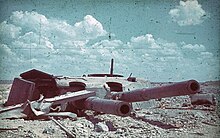Battle of Crimea (1941)
| Crimean Campaign | |||||||
|---|---|---|---|---|---|---|---|
| Part of the Eastern Front of World War II | |||||||
 Destroyed naval artillery at Sevastopol |
|||||||
|
|||||||
| Belligerents | |||||||
|
|
|
||||||
| Commanders and leaders | |||||||
|
|
|
||||||
| Units involved | |||||||
|
11th Army Romanian 3rd Army |
51st Army Separate Coastal Army |
||||||
| Casualties and losses | |||||||
| 30,000 dead wounded or missing | 65,000 captured 212 Vehicles destroyed 672 guns 1 tanker damaged |
||||||
The Crimea Campaign was an eight-month-long campaign by Axis forces to conquer the Crimea peninsula, and was the scene of some of the bloodiest battles on the Eastern Front during World War II. The German, Romanian, and defending Soviet troops suffered heavy casualties as the Axis forces tried to advance through the Isthmus of Perekop linking the Crimean peninsula to the mainland at Perekop, from summer of 1941 through to the first half of 1942.
From 26 September 1941 the German 11th Army and troops from the Romanian Third Army and Fourth Army were involved in the fighting, opposed by the Red Army's 51st Army and elements of the Black Sea Fleet. After the campaign, the peninsula was occupied by Army Group A with the 17th Army as its major subordinate formation.
Once the Axis (German and Romanian troops) broke through, they occupied most of Crimea, with the exception of the city of Sevastopol, which was given the title of Hero City for its resistance, and Kerch, which was recaptured by the Soviets during an amphibious operation near the end of 1941 and then taken once again by the Germans during Operation Bustard Hunt on 8 May. The Siege of Sevastopol lasted 250 days from 30 October 1941 until 4 July 1942, when the Axis finally captured the city.
...
Wikipedia
